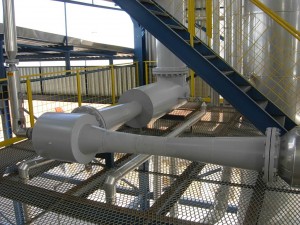Vacuum Packing – Embalagem a Vácuo
out 21 Number of View :3919Why vacuum packing?
Foods maintain their freshness and flavor 3-5 times longer than with conventional storage methods, because they don’t come in contact with oxygen. Instead of showing a traditional vacuum packing machine, you will understand better how it works with this uncommon video.
Funny comments are allowed.
embedded by Embedded Video
Por que embalar a vácuo?
Os alimentos mantem o frescor e sabor por um tempo 3 a 5 vezes maior do que com os métodos convencionais de armazenamento. Os alimentos embalados a vácuo não entram em contato com o oxigênio, e duram mais. Em vez de mostrar uma máquina de embalagem a vácuo tradicional, você vai entender melhor como ela funciona com este vídeo incomum.
Comentários engraçados são permitidos.
Installation and How Works a Paper Machine – Montagem e Funcionamento de uma Máquina de Papel
out 18 Number of View :4974Paper is a product we heard that would disappear with the use of electronic documents, but what we see is an ever increasing market for paper products. Everybody knows what paper is, but very few know how it is produced. Now you may ask why I am posting these two videos. What does a paper machine have to do with vacuum?
The answer is very simple. The heart of a paper machine is normally hidden from the eyes of a visitor. The heart of a paper machine is the set of vacuum pumps installed to remove the water of the pulp in order to form the paper sheet. The Liquid Ring Vacuum Pumps.
You will now see the video of the installation of a paper machine and a video from Voith of how the modern paper machine is started.
embedded by Embedded Video
embedded by Embedded Video
O papel é um produto que muitos diziam iria desaparecer com o uso de documentos eletrônicos, mas o que vemos é um mercado cada vez maior. Todo mundo sabe o que é o “papel”, mas muito poucos sabem como ele é produzido. Agora você pode perguntar por que estou postando esses dois vídeos. O que uma máquina de papel tem a ver com o vácuo?
A resposta é muito simples. O coração de uma máquina de papel está normalmente escondido dos olhos de um visitante. O coração de uma máquina de papel é o conjunto de bombas de vácuo instalado para remover a água da polpa e assim formar a folha de papel. As Bombas de Vácuo de Anel Líquido.
Você verá nos vídeos acima a montagem de uma máquina de papel e como é o início de produção em uma moderna máquina de papel da Voith.
Steam Jet Ejectors in Fats and Oils Processing – Ejetores a Vapor no Processamento de Óleos e Gorduras
out 05 Number of View :13377For many years, steam jet ejectors have offered a reliable and economical means of producing vacuum in fats and oils processing. They have a low installed cost and, though the simplicity of their construction, provide years of trouble-free operation. Steam ejectors continue to evolve with the development of new materials of construction, new nozzle configurations and other innovations that enhance the benefits of the basic technology.
Then why are ejectors and the vacuum systems so different from manufacturer to manufacturer?
CLICK HERE to know the answer in the article I wrote to the AOCS .
Por muitos anos, os ejetores a vapor têm sido um meio confiável e econômico de gerar vácuo no processamento dos óleos e gorduras. Eles têm baixo custo de instalação e apesar da simplicidade de sua construção, proporcionam anos de operação sem problemas. Os ejetores continuam a evoluir com o desenvolvimento de novos materiais de construção, novas configurações de bicos motrizes e outras inovações que melhoram o desempenho.
Por que então os ejetores e sistemas de vácuo são tão diferentes de fabricante para fabricante?
CLIQUE AQUI e leia mais no artigo que escrevi para o AOCS. Este artigo está disponível somente em inglês.
Magdeburg Experiment – Experimento de Magdeburg
out 01 Number of View :10301The history of vacuum pumping system engineering begins with Guericke’s experiment at Magdeburg in northern Germany in 1654. Earlier in the century, Galileo Galilei had reported the creation of a partial vacuum formed by withdrawing a piston from a cylinder. Evangelista Torricelli invented the mercury barometer in 1643. The first vacuum pump was invented by Otto von Guericke around 1650. This pump was used in the famous “Magdeburg hemispheres” experiment in which 16 horses were unable to separate two evacuated copper hemispheres.
This text was extracted from the book Process Vacuum System Design & Operation, by James L. Ryans and Daniel L. Roper – McGraw-Hill Book Company, 1986 ISBN 0-07-054355-0 , in my humble opinion, the best book about vacuum process.
You are about to see a reenactment of this experiment staged by the Technical University of Ilmenau and a the recreation made by Russell Zeid, educator at the Ontario Science Centre .
embedded by Embedded Video
embedded by Embedded Video
A história da engenharia de sistemas de vácuo começa com o experimento de Guericke em Magdeburg, na Alemanha do Norte em 1654. No começo do século, Galileu Galilei tinha relatado a criação de um vácuo parcial obtido mediante a retirada de um pistão de um cilindro. Evangelista Torricelli inventou o barômetro de mercúrio em 1643. A bomba de vácuo foi inventada por Otto von Guericke em 1650. Esta bomba foi usada no famoso experimento dos “hemisférios de Magdeburgo”, no qual 16 cavalos foram incapazes de separar os dois hemisférios de cobre previamente evacuados.
Este texto foi extraído do livro Process Vacuum System Design & Operation, de James L. Ryan e Daniel L. Roper – McGraw-Hill Book Company, 1986 ISBN 0-07-054355-0, na minha humilde opinião, o melhor livro sobre vácuo.
Você está prestes a ver uma reconstituição deste experimento organizado pela Universidade Técnica de Ilmenau e uma recriação do feito por Russell Zeid, educador no Ontario Science Centre.



